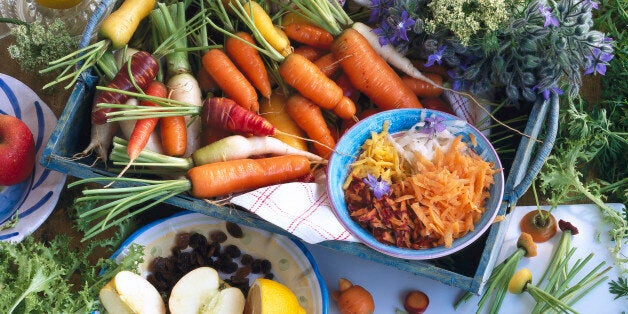
I love my greens and almost every other vegetable on the planet. I could quite easily be a vegetarian. However, as I have a number of meat lovers in my home, this would mean preparing different meals for the family every night. So we have the perfect compromise: The Flexi Veggie.
The Flexi Veggie regime involves eating meat or fish four or five days a week and then having 2 or 3 days of vegetarian or meatless meals. As proteins can be sourced from both animal and plants this makes it possible to obtain enough proteins from plants like legumes, nuts and seeds. And do you know what, it's really tasty!
We can certainly choose to live without meat, but can we live without eating a single vegetable? The answer is quite obviously no and yet according to recent statistics, fruit and vegetable consumption is falling. This alarms me, particularly given the light that is always shun on vegetable goodness!
I is for Importance
Vegetables form part of a balanced diet, as they are an excellent source of micronutrients, which are better known as essential minerals and vitamins. Essential means that our bodies cannot make these particular nutrients and therefore the only way for a healthy person to get them is via the food we eat.
There are approximately fifteen essential minerals and thirteen vitamins (many working together and each playing a vital role in keeping us healthy). Not eating enough vegetables, or their sugary sibling, the fruit, can increase your risk for health problems later on in life, including heart disease, strokes, some cancer, and poor bone health. On a day to day basis, vegetables provide energy, glossy hair and clear skin. Likewise, the fibre consumed through eating vegetables (especially when they are unpeeled) helps to keep our gut working efficiently, preventing constipation.
Now isn't that enough reasons to like your vegetables?
F is for Five a Day
We are all familiar with the World Health Organisation's guidelines of 'Five a Day'. It's pushed down our throats every day.
However, there are other guidelines which you may not have heard of. In fact, the WHO recommend that of the 'Five a Day', at least three should be made up of vegetable portions. This is because of the high sugar content in fruit (I have written on this before should you want to dig deeper).
The NHS Eatwell Plate recommends that 33% of food eaten on a daily basis should come from fruit and vegetables.
Furthemore, the famous Mayo Clinic Healthy Weight Pyramid suggests a minimum of three servings a day of fruit and four servings a day of vegetables.
The Havard School of Medicine goes a little further and suggests between five and, a whopping, thirteen portions of fruit and vegetables a day.
There's no doubt that we need to get our vegetable intake up. Planning several meals each week with vegetables at centre stage is key.
P is for Portion
I have written about portion sizes before, but I am love, love, loving this handy resource from the NHS which tells you exactly what a fruit and vegetable portion size is. 3 'whole' baby beetroots? Half a courgette? 3 stalks of celery?
Print it out, pin it up and get aware.
B is for Barriers
There are often claims that the rising cost of fruit and vegetables act as barriers to eating vegetables. Likewise I often hear protests relating to the difficulty in preparing veggies. B is for Bull, in my opinion. Nowadays frozen and selective tinned vegetables eg tomatoes can retain most of the nutrients and are cheap and easy to prepare.
However, there are other barriers. A new study has thrown some insight into the reason why some children (and if not addressed, many adults) will not eat their vegetables. Call them fussy if you want, but you might be wrong as University College London researcher Professor Jane Wardle discovered recently.
While a fondness for chocolate, crisps and all that unhealthy processed food that children like, can be blamed on the home environment, Wardle found that genes are to blame for disliking the taste of the average vegetables. So parents, we can stop feeling guilty for children not liking their greens! But you're not off the hook quite yet. If your children prefer processed foods, including unhealthy snacks, chocolates and confectionary, that is your fault!! Professor Wardle who conducted the research which was published in the American Journal of Clinical Nutrition, reported that further work shows that giving a child a tiny amount of a disliked vegetable every day for ten days could make all the difference. So get working!